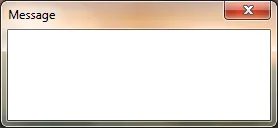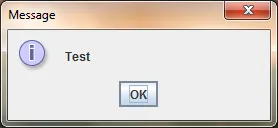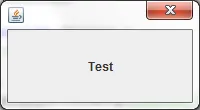我在使用Swing时遇到了一个问题,只有在计算机显示器关闭时才会出现,但我的Swing应用程序仍在后台运行。似乎每当显示器关闭时,Swing/AWT会取消所有绘制操作,导致GUI中出现一些显示问题,这些问题在显示器重新打开后立即可见。
例如,当我使用自定义的JNI函数关闭显示器,然后打开一个简单的消息对话框时,当显示器重新打开时,消息对话框是空白的。
编辑:这是一个SSCCE示例:
我正在使用64位的Windows 7 Home Premium SP1和64位的Java 1.6.0_24。
编辑2:这是另一个我遇到“取消绘画操作”效果的程序。
在显示器关闭之前,我看到:
例如,当我使用自定义的JNI函数关闭显示器,然后打开一个简单的消息对话框时,当显示器重新打开时,消息对话框是空白的。


编辑:这是一个SSCCE示例:
package test;
import javax.swing.JOptionPane;
import javax.swing.SwingUtilities;
public class App {
public static void main(String[] args) throws Throwable {
System.out.println("***** Please turn off the monitor in the next 70 seconds *****");
Thread.sleep(1000L * 70);
SwingUtilities.invokeLater(new Runnable() {
@Override
public void run() {
JOptionPane.showMessageDialog(null, "Test");
}
});
}
}
我正在使用64位的Windows 7 Home Premium SP1和64位的Java 1.6.0_24。
编辑2:这是另一个我遇到“取消绘画操作”效果的程序。
package test;
import static com.mycompany.Util.turnOffMonitors;
import java.awt.BorderLayout;
import java.awt.Color;
import java.awt.Container;
import java.awt.Dimension;
import javax.swing.JDialog;
import javax.swing.JFrame;
import javax.swing.JLabel;
import javax.swing.SwingUtilities;
public class DialogTest extends JDialog {
private final JLabel label;
public DialogTest() {
setDefaultCloseOperation(JDialog.DISPOSE_ON_CLOSE);
label = new JLabel("Test", JLabel.CENTER);
label.setOpaque(true);
Container contentPane = getContentPane();
contentPane.setLayout(new BorderLayout());
contentPane.add(BorderLayout.CENTER, label);
this.setPreferredSize(new Dimension(200, 110));
pack();
setLocationRelativeTo(null);
setVisible(true);
Thread t = new Thread() {
@Override
public void run() {
turnOffMonitors();
try {
Thread.sleep(3000L);
} catch (InterruptedException ex) { }
SwingUtilities.invokeLater(new Runnable() {
@Override
public void run() {
label.setBackground(Color.YELLOW);
}
});
}
};
t.start();
}
public static void main(String[] args) throws Throwable {
SwingUtilities.invokeLater(new Runnable() {
public void run() {
new DialogTest();
}
});
}
}
在显示器关闭之前,我看到:


编辑3:已向Oracle报告Bug ID 7049597。